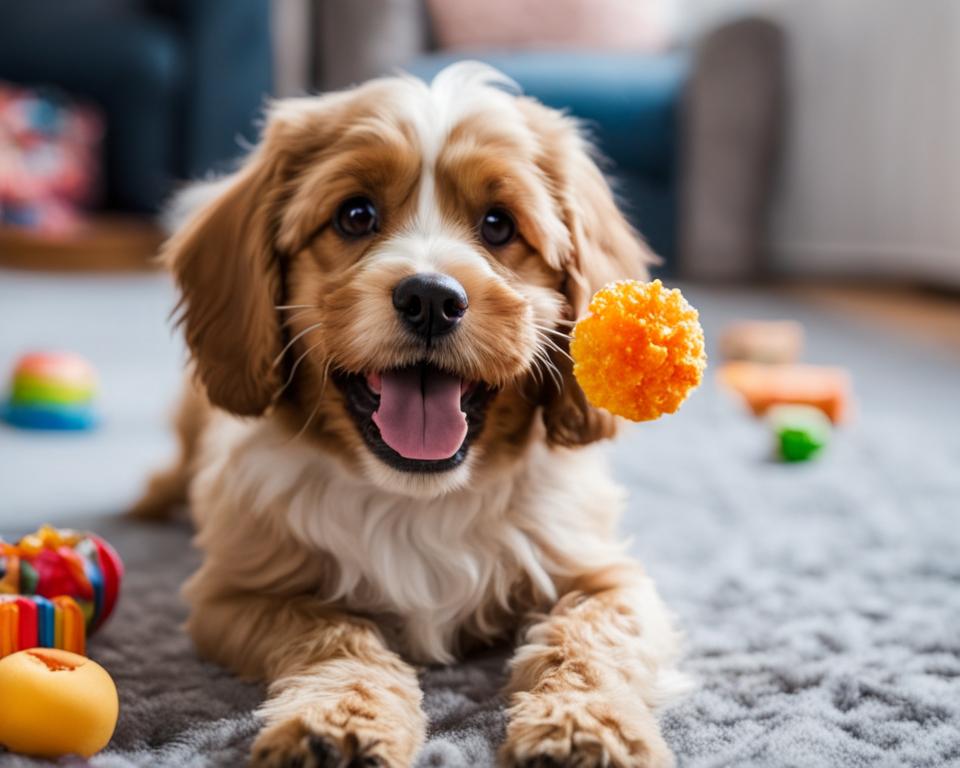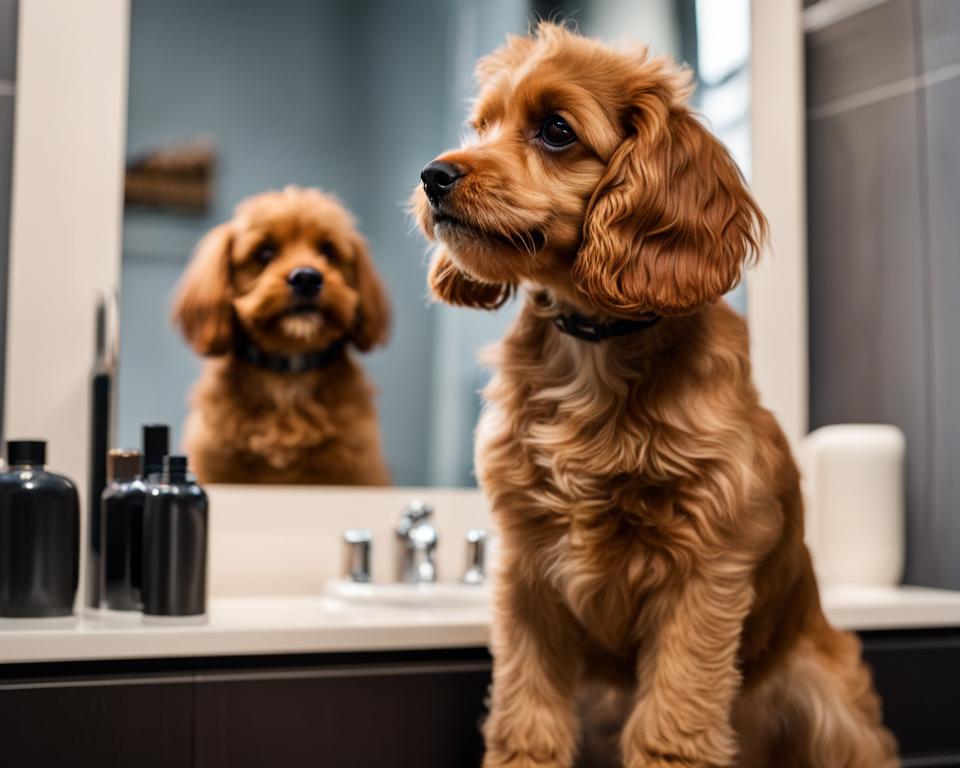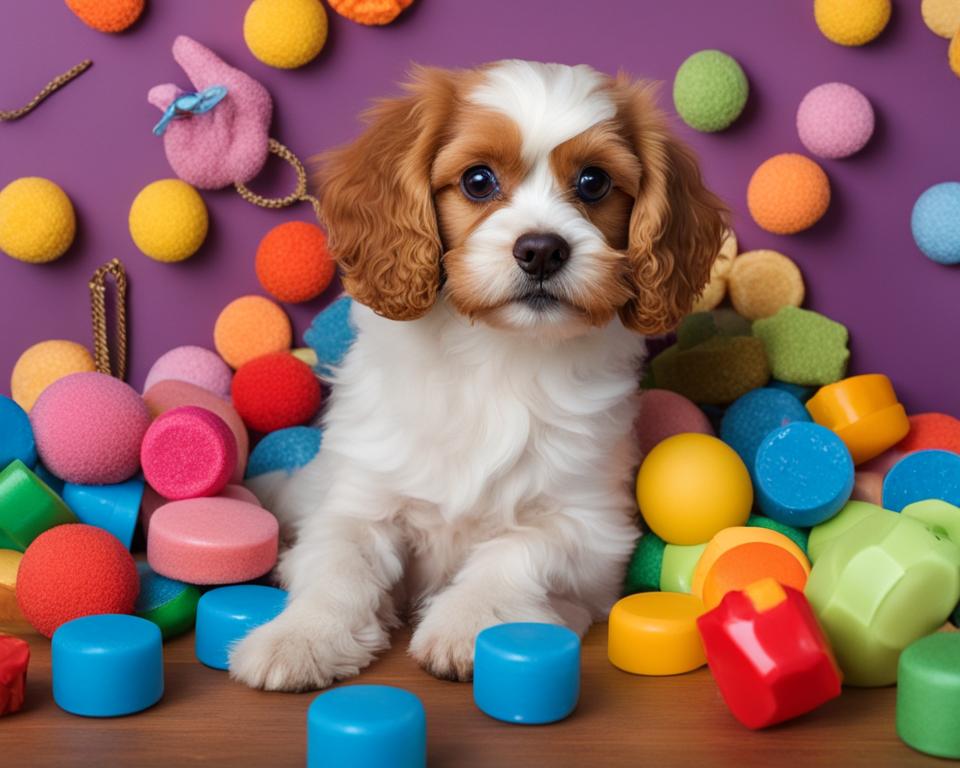Cavapoos are popular companions known for their calm demeanor and intelligence. Timely and consistent training is crucial for their development. Starting training early is recommended, and ethical breeders may introduce basic training even before bringing the pup home. Setting a daily routine and establishing healthy boundaries is important. Positive reinforcement training is key to successful Cavapoo training. Crate training, clicker training, and mirror training can be effective methods. It’s important to have the right training equipment, such as treats, collar and leash, toys, and grooming tools.
Key Takeaways:
- Timely and consistent training is crucial for Cavapoos’ development.
- Start training early and set a daily routine to establish healthy boundaries.
- Positive reinforcement training is key for successful Cavapoo training.
- Crate training, clicker training, and mirror training are effective methods.
- Having the right training equipment is important for effective training.
When to Start Training Your Cavapoo Puppy
Training your Cavapoo puppy should start as early as possible to establish good behaviors and a strong foundation for their development. Starting training from a young age allows you to shape their behavior and build a bond based on trust and mutual understanding. By beginning training early, you can help your Cavapoo puppy grow into a well-behaved and obedient adult.
The optimal time to start training a Cavapoo puppy is around 8 to 10 weeks old. At this age, puppies are more receptive to learning and can easily adapt to new experiences. Some ethical breeders may introduce basic training while the puppies are still in their care, ensuring a smooth transition when they come home to you.
During the early stages of training, focus on essential aspects such as crate training, potty training, leash walking, and basic manners. Consistency and patience are key during this stage, as Cavapoo puppies have short attention spans. Establishing a daily routine that includes specific mealtimes, potty breaks, exercise/playtime, and bedtime will help create healthy boundaries and structure for your puppy to thrive.
https://www.youtube.com/watch?v=SpZT0ZpjiX8
Remember, every puppy is unique, and training progress may vary. Be sure to tailor your training techniques to suit your Cavapoo puppy’s individual needs and personality. With time, patience, and positive reinforcement, you can lay the groundwork for a well-behaved and happy Cavapoo companion.
The Importance of Positive Reinforcement Training for Cavapoos
Positive reinforcement training is a highly effective and recommended approach for training Cavapoos. This method focuses on rewarding desirable behaviors with treats, toys, and praise, rather than using punishment or scolding. By reinforcing positive behaviors, Cavapoos develop a strong bond with their owners and learn to associate good behavior with positive outcomes.
Training Cavapoos with positive reinforcement is beneficial for their overall well-being and mental health. Punishing or scolding can cause anxiety and stress in these sensitive and intelligent dogs, potentially leading to behavioral issues. On the other hand, positive reinforcement helps build trust and a positive learning environment.
Clicker training is one form of positive reinforcement that works particularly well with Cavapoos. This technique involves using a clicker to mark desired behaviors, followed by a reward. The clicker becomes a conditioned stimulus that signifies a reward is coming. Cavapoos quickly learn to associate the clicking sound with a positive outcome and are motivated to repeat the behavior.
Benefits of Positive Reinforcement Training for Cavapoos:
- Creates a positive learning environment
- Strengthens the bond between owner and Cavapoo
- Builds trust and confidence in the dog
- Encourages desired behaviors through rewards
- Reduces stress and anxiety
By using positive reinforcement training techniques, Cavapoos can undergo effective and enjoyable training sessions that enhance their obedience and overall behavior. It’s important to remember that each Cavapoo is unique, so training methods should be tailored to their individual personality and needs.

| Training Method | Description |
|---|---|
| Crate Training | Teaches Cavapoos to view their crate as a safe and comfortable space |
| Clicker Training | Uses a clicker to mark desired behaviors, followed by a reward |
| Mirror Training | Teaches Cavapoos to mimic the actions of their owners |
Crate Training as an Effective Cavapoo Training Method
Crate training is a popular and effective method for training Cavapoos. It provides them with a safe space where they can relax and feel secure. Crate training can also help with Cavapoo potty training and curb unwanted behaviors. It’s important to never use the crate as a form of punishment. The goal is to make the crate a positive and comfortable place for the Cavapoo. Gradual introduction and positive reinforcement, such as treats and praise, can help the Cavapoo associate the crate with positive experiences.
Cavapoos are naturally den-dwelling animals, making them more receptive to crate training. The crate simulates a cozy den environment, creating a sense of security for the Cavapoo. It also helps with house training, as dogs have an innate instinct to keep their sleeping area clean. When properly crate trained, Cavapoos will learn to hold their bladder and bowels until they are taken outside. This promotes good potty habits and prevents accidents in the house.
Introducing the crate to a Cavapoo should be a gradual process to ensure they feel comfortable and accept it as their own space. Start by placing the crate in a quiet area of the house and leave the door open. Allow the Cavapoo to explore the crate freely and reward them with treats and praise for going near or inside the crate. Gradually increase the amount of time the Cavapoo spends in the crate, always making it a positive experience. Eventually, they will associate the crate with relaxation and security.
| Benefits of Crate Training for Cavapoos |
|---|
| 1. Provides a safe and secure space for the Cavapoo |
| 2. Helps with potty training and prevents accidents |
| 3. Reduces anxiety and promotes relaxation |
| 4. Facilitates travel and prevents destructive behaviors in unfamiliar environments |
| 5. Assists with managing separation anxiety |
Clicker Training for Cavapoos
Clicker training is a highly effective method for training Cavapoos. This technique utilizes a clicker device that produces a distinct clicking sound, which is used to mark desired behaviors in the dog. The clicker acts as a signal to the Cavapoo that it has performed the correct action and will be rewarded. This clear and consistent feedback helps the Cavapoo understand what is expected of them, making the training process more efficient and enjoyable.
How Clicker Training Works
Clicker training involves a two-step process: the conditioning phase and the training phase. During the conditioning phase, the Cavapoo is taught to associate the sound of the clicker with a reward, such as a treat or praise. This is achieved by clicking the device and immediately following it with a reward. Over time, the Cavapoo will come to understand that the clicker sound signifies a job well done.
Once the Cavapoo has been conditioned to understand the clicker, the training phase can begin. The trainer can use the clicker to mark and reinforce specific behaviors they want the Cavapoo to learn. For example, if the trainer wants the Cavapoo to sit, they can click the device the moment the dog’s bottom touches the ground and immediately provide a reward. With consistent practice, the Cavapoo will start to associate the desired behavior with the clicker sound and will perform it more frequently.

The Benefits of Clicker Training for Cavapoos
Clicker training offers several benefits for training Cavapoos. Firstly, it provides a clear and concise way to communicate with the dog, reinforcing desired behaviors and shaping their understanding of commands. The clicker sound is distinct, making it easy for the Cavapoo to recognize and associate with positive outcomes.
Additionally, clicker training allows for precise timing and accuracy. The click occurs the moment the desired behavior is performed, providing immediate feedback to the Cavapoo. This helps them understand exactly what action led to the reward, speeding up the learning process.
Furthermore, clicker training is a positive and reward-based method, which promotes a strong bond between the Cavapoo and their trainer. The Cavapoo learns to trust and rely on their trainer for guidance and rewards, leading to a harmonious relationship and effective training outcomes.
| Benefits of Clicker Training for Cavapoos |
|---|
| Precise communication with explicit feedback |
| Fast and effective learning through immediate reinforcement |
| Promotes a positive bond between the Cavapoo and trainer |
Mirror Training for Cavapoos
Mirror training is a unique method that combines positive reinforcement and clicker training techniques to teach Cavapoos to mirror their owner’s actions. This training method takes advantage of the breed’s eagerness to please and their ability to learn by observation. By using reward training and clicker cues, owners can effectively teach Cavapoos to mimic actions such as sitting, lying down, or even performing simple tricks.
The benefits of mirror training for Cavapoos are multi-faceted. Firstly, it provides mental stimulation and engages their intelligence, allowing them to learn new behaviors and commands more quickly. Secondly, it strengthens the bond between the Cavapoo and their owner through interactive training sessions. Lastly, mirror training helps develop the dog’s focus and attention, improving their overall obedience and responsiveness.
How Does Mirror Training Work?
Mirror training involves using a mirror as a visual aid to help Cavapoos understand and imitate their owner’s actions. Here’s a step-by-step guide to getting started with mirror training:
- Place a mirror in a location where both you and your Cavapoo can easily see it.
- Begin with simple actions, like sitting or lying down, in front of the mirror.
- Use the clicker to mark the desired behavior and immediately reward your Cavapoo with a treat.
- Repeat the process, gradually adding more complex actions or tricks as your Cavapoo becomes comfortable with mirror training.
- Consistency and repetition are key to reinforcing the behavior and helping your Cavapoo understand the concept of mirroring.
Remember to keep training sessions short and positive, always rewarding your Cavapoo for successful mirroring. With patience and practice, mirror training can be a fun and effective way to train your Cavapoo and strengthen your bond.

Table: Pros and Cons of Mirror Training for Cavapoos
| Pros | Cons |
|---|---|
| Engages the Cavapoo’s intelligence | Requires patience and consistency |
| Strengthens the bond between owner and dog | May not work for all Cavapoos |
| Provides mental stimulation | Requires a mirror as a training aid |
| Improves focus and attention | May take time for the Cavapoo to understand the concept |
Training Equipment for Cavapoos
Cavapoos are intelligent and trainable companions, but to ensure effective training, it’s essential to have the right equipment. The following are some recommended training tools and essential items for Cavapoo training:
1. Treat Pouch:
- A treat pouch allows you to have treats readily available during training sessions.
2. Soft Collar and Harness:
- A soft collar and harness provide comfort and control during walks and training exercises.
3. 2-Meter Training Leash:
- A long training leash allows freedom of movement for your Cavapoo while still providing control and safety.
4. Non-Slip Vet Bed or Soft Mat:
- A non-slip vet bed or soft mat provides a comfortable and secure surface for your Cavapoo to rest and relax.
5. High-Value Treats:
- High-value treats, such as small pieces of cooked chicken or cheese, can be used as rewards during training to motivate your Cavapoo.
6. Two Identical Toys for Swaps:
- Having two identical toys allows you to practice the “swap” command, teaching your Cavapoo to release one toy in exchange for another.
7. Soft Grooming Brush:
- A soft grooming brush helps keep your Cavapoo’s coat clean and free from tangles, making grooming a positive experience.
8. Crate and Playpen (Optional):
- A crate and playpen can be useful for crate training, providing a secure space for your Cavapoo when you’re unable to supervise.
By having these essential items, you’ll be well-equipped to engage in positive and effective training sessions with your Cavapoo. Remember to always use positive reinforcement and patience when training, creating a bond built on trust and mutual understanding.
Common Behavioral Issues in Cavapoos
Cavapoos, like any breed, may experience certain behavioral issues that require attention and training. Addressing these unwanted behaviors is crucial for a well-behaved and happy Cavapoo.
Some common Cavapoo training challenges include counter surfing, jumping on people, and excessive barking. Counter surfing, where the dog steals food from countertops or tables, can be frustrating and potentially dangerous. Jumping on people is a natural behavior for Cavapoos seeking attention, but it can become problematic if not properly managed. Excessive barking can be a sign of anxiety, boredom, or lack of appropriate mental and physical stimulation.
Fortunately, these behavioral issues can be effectively addressed through training and consistent reinforcement of desired behaviors. Using positive reinforcement methods, such as rewarding good behavior and redirecting or ignoring unwanted behavior, can help shape the Cavapoo’s behavior in a positive way. Establishing clear boundaries and consistent routines are important for managing and preventing these issues.
In addition to training, it’s important to understand the breed’s genetic traits and provide appropriate mental and physical stimulation. Cavapoos are intelligent and active dogs that thrive with regular exercise, interactive playtime, and mental challenges. Proper socialization with people and other animals is also essential for a well-rounded Cavapoo.
FAQ
When should I start training my Cavapoo puppy?
It is recommended to start training your Cavapoo puppy as early as possible. Ethical breeders may introduce basic training even before bringing the pup home.
What is the importance of positive reinforcement training for Cavapoos?
Positive reinforcement training is highly effective for training Cavapoos. It involves rewarding good behaviors or completed tasks with treats, toys, and praise, which helps shape their behavior positively.
How can I effectively crate train my Cavapoo?
Crate training is a popular and effective method for training Cavapoos. It provides them with a safe space and can help with potty training and curbing unwanted behaviors. Gradual introduction and positive reinforcement are key.
What is clicker training and how can I use it for my Cavapoo?
Clicker training is a popular method that involves using a clicking sound to mark desired behaviors, followed by a reward. It can be used to teach Cavapoos various commands and tricks by associating the click with positive outcomes.
What is mirror training and how can it benefit my Cavapoo?
Mirror training is a method that combines positive reinforcement and clicker training to teach your Cavapoo to mimic your actions. It can be an effective way to engage their intelligence and eagerness to please.
What training equipment do I need for my Cavapoo?
Recommended training equipment for Cavapoos includes a treat pouch, soft collar, harness, training leash, non-slip vet bed or soft mat, high-value treats, toys for swaps, grooming brush, and crate or playpen (optional).
What are common behavioral issues in Cavapoos and how can I address them?
Common behavioral issues in Cavapoos include counter surfing, jumping on people, and excessive barking. These can be addressed through training and consistent reinforcement of desired behaviors, along with proper socialization and mental/physical stimulation.

Leave a Reply